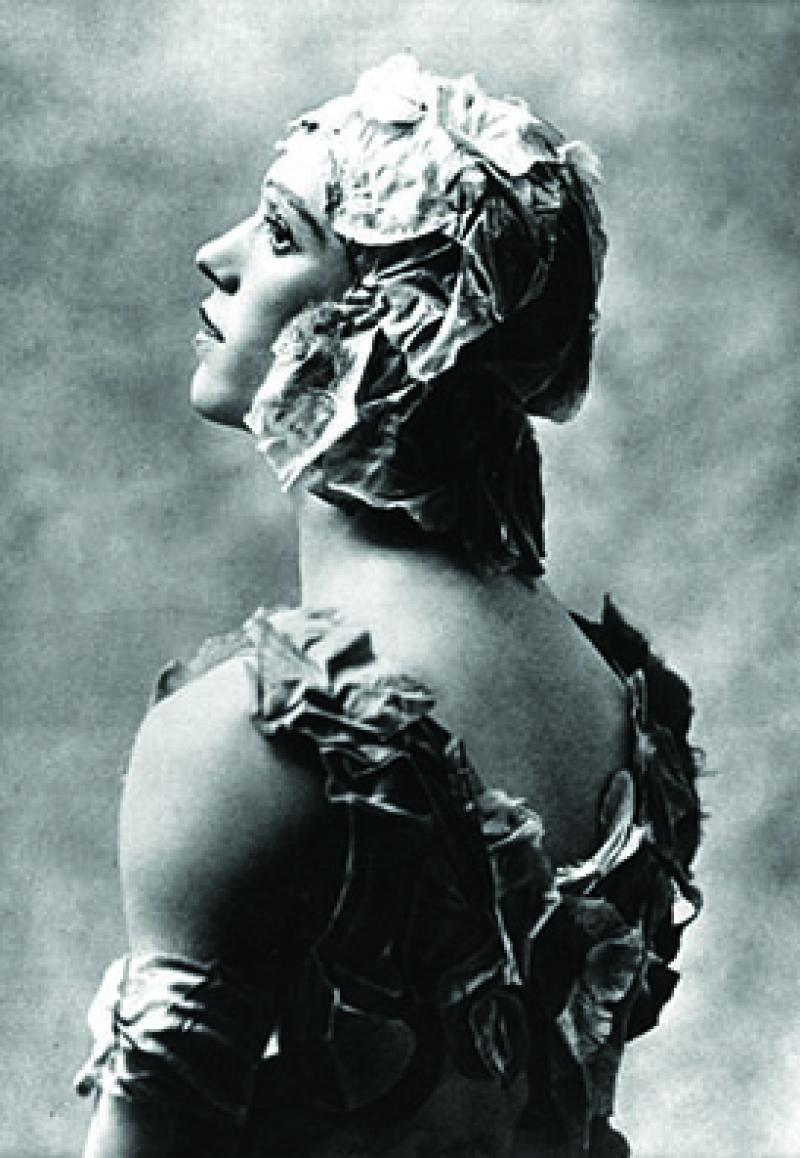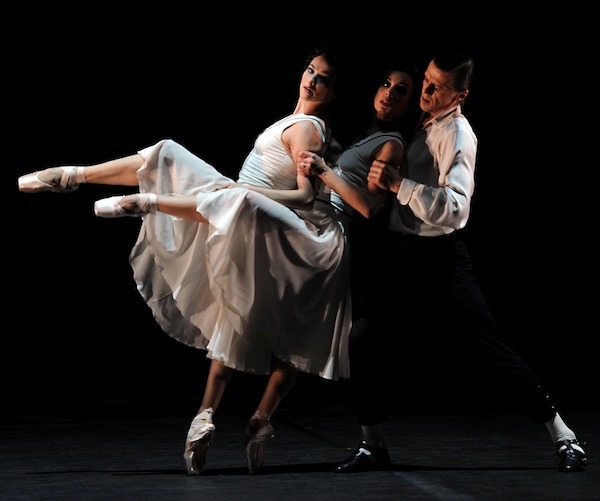Russian Ballet Icons Gala: Celebrating Vaslav Nijinsky, London Coliseum | reviews, news & interviews
Russian Ballet Icons Gala: Celebrating Vaslav Nijinsky, London Coliseum
Russian Ballet Icons Gala: Celebrating Vaslav Nijinsky, London Coliseum
What does a starry gala say about today's valuation of yesterday's legend?

What does _ _ _ _ mean to you? What does _ _ _ _ mean to us all? Questions asked every day by all kinds of people the world over. These same questions were posed last night at the London Coliseum about the doyen of 20th-century dance and choreography, Vaslav Nijinsky, at one of the Russian Ballet Icons galas that annually pack in an audience mostly made up of the Russian community London has now come to call its own.
Nijinsky (to me, as a male dancer in my thirties) is responsible for a number of things: first, changing what it meant to be a male dancer; second, defining a new way of moving; and third, introducing original music choices to dance and making them stick. Fourteen pieces and extracts were on offer, linking key Nijinsky roles in versions that with time have strayed far from their sources, and others where music or theme connected with his time and place.
The curtain rose on Fokine’s Petrushka, a befitting choice, what with the lone misunderstood figure echoing how Nijinsky must have often felt. And English National Ballet’s Dmitri Gruzdyev did the role proud with his overt physical approach backed up by a touchingly emotional bewilderment.
Nuñez reconfirmed the electrifying period her dancing is currently experiencing
The farewell pas de deux for Masha and Vershinin from Kenneth MacMillan’s Winter Dreams followed, its Chekhov derivation a very slight connection to the theme, and the Royal Ballet’s Marianela Nuñez and Thiago Soares executed the choreography’s expressive expansion well. Nuñez reconfirms the electrifying period her dancing is currently experiencing no matter what the night, work, or theatre she finds herself in.
Balanchine’s Diamonds pas de deux was somewhat initially spoilt by seeing the jewel-encrusted tutu-clad ballerina (the Bolshoi’s Evgenia Obraztsova) dashing onto the stage in the darkness to remove Vershinin’s coat from the floor! Where were the technical staff, one asks in amazement? Thankfully Obraztsova has the most divine carriage of the upper body and arms, as well as footwork that sparkles like the most precious of diamonds. Though Bolshoi principal Artem Ovcharenko’s weak partnering didn’t allow her to truly make the most of Balanchine’s precarious choreography throughout.
In Fokine’s Le Spectre de la Rose, one of Nijinsky's most subtly pioneering roles, former Royal Ballet principal Ivan Putrov danced the legendary fleur acceptably, though he took a little too long to realise the physical exuberance of the role for me. These issues didn’t seem to faze English National Ballet's Elena Glurdjidze though – whose interpretation of the woman besotted with the rose’s fragrance felt authentic from start to finish.
 The second half proffered two points of interest – the first being Wayne Eagling’s (also the evening’s artistic director) interpretation of Nijinsky’s Jeux, his final creation for English National Ballet before he left its directorship last year.
The second half proffered two points of interest – the first being Wayne Eagling’s (also the evening’s artistic director) interpretation of Nijinsky’s Jeux, his final creation for English National Ballet before he left its directorship last year.
The 1913 poème dansé was a pioneering work, and Eagling’s version features facets I imagine were present in the original. The high-fashion aesthetic of the original tennis party, first realised by Coco Chanel, was elegantly reworked by Wizzy Shawyer. (Pictured right, Dmitri Gruzdyev, Fernanda Oliveira, Elena Glurdjidze) And the dance language itself – which trailblazed the significance of pictorial image within movement phrasing - was a Nijinsky trait that Eagling picked up and ran with.
The night’s crowdpleaser came in the form of Balanchine’s Tchaikovsky pas de deux. The choreography is so chic and fresh in style it needs little help to make it soar – but if the dancers can parallel its understated glamour then a treat is most definitely in store. The Royal Danish Ballet’s J’Aime Crandall and Alban Lendorf did the necessary parallel and more – she demonstrating a physical strength that would take a hurricane to unsteady, he advocating that the Bournonville schooling is still one of the best in the world, and that the dynamic élan continues to evolve post graduation.
The gala's production values were too low for me throughout, and cloud the overall experience. Did the event do Nijinsky justice? Initially I thought, no... but on reflection, perhaps yes (in a roundabout way).
rating
Explore topics
Share this article
Add comment
The future of Arts Journalism
You can stop theartsdesk.com closing!
We urgently need financing to survive. Our fundraising drive has thus far raised £49,000 but we need to reach £100,000 or we will be forced to close. Please contribute here: https://gofund.me/c3f6033d
And if you can forward this information to anyone who might assist, we’d be grateful.

Subscribe to theartsdesk.com
Thank you for continuing to read our work on theartsdesk.com. For unlimited access to every article in its entirety, including our archive of more than 15,000 pieces, we're asking for £5 per month or £40 per year. We feel it's a very good deal, and hope you do too.
To take a subscription now simply click here.
And if you're looking for that extra gift for a friend or family member, why not treat them to a theartsdesk.com gift subscription?
more Dance
 'We are bowled over!' Thank you for your messages of love and support
Much-appreciated words of commendation from readers and the cultural community
'We are bowled over!' Thank you for your messages of love and support
Much-appreciated words of commendation from readers and the cultural community
 Peaky Blinders: The Redemption of Thomas Shelby, Rambert, Sadler's Wells review - exciting dancing, if you can see it
Six TV series reduced to 100 minutes' dance time doesn't quite compute
Peaky Blinders: The Redemption of Thomas Shelby, Rambert, Sadler's Wells review - exciting dancing, if you can see it
Six TV series reduced to 100 minutes' dance time doesn't quite compute
 Giselle, National Ballet of Japan review - return of a classic, refreshed and impeccably danced
First visit by Miyako Yoshida's company leaves you wanting more
Giselle, National Ballet of Japan review - return of a classic, refreshed and impeccably danced
First visit by Miyako Yoshida's company leaves you wanting more
 Quadrophenia, Sadler's Wells review - missed opportunity to give new stage life to a Who classic
The brilliant cast need a tighter score and a stronger narrative
Quadrophenia, Sadler's Wells review - missed opportunity to give new stage life to a Who classic
The brilliant cast need a tighter score and a stronger narrative
 The Midnight Bell, Sadler's Wells review - a first reprise for one of Matthew Bourne's most compelling shows to date
The after-hours lives of the sad and lonely are drawn with compassion, originality and skill
The Midnight Bell, Sadler's Wells review - a first reprise for one of Matthew Bourne's most compelling shows to date
The after-hours lives of the sad and lonely are drawn with compassion, originality and skill
 Ballet to Broadway: Wheeldon Works, Royal Ballet review - the impressive range and reach of Christopher Wheeldon's craft
The title says it: as dancemaker, as creative magnet, the man clearly works his socks off
Ballet to Broadway: Wheeldon Works, Royal Ballet review - the impressive range and reach of Christopher Wheeldon's craft
The title says it: as dancemaker, as creative magnet, the man clearly works his socks off
 The Forsythe Programme, English National Ballet review - brains, beauty and bravura
Once again the veteran choreographer and maverick William Forsythe raises ENB's game
The Forsythe Programme, English National Ballet review - brains, beauty and bravura
Once again the veteran choreographer and maverick William Forsythe raises ENB's game
 Sad Book, Hackney Empire review - What we feel, what we show, and the many ways we deal with sadness
A book about navigating grief feeds into unusual and compelling dance theatre
Sad Book, Hackney Empire review - What we feel, what we show, and the many ways we deal with sadness
A book about navigating grief feeds into unusual and compelling dance theatre
 Balanchine: Three Signature Works, Royal Ballet review - exuberant, joyful, exhilarating
A triumphant triple bill
Balanchine: Three Signature Works, Royal Ballet review - exuberant, joyful, exhilarating
A triumphant triple bill
 Romeo and Juliet, Royal Ballet review - Shakespeare without the words, with music to die for
Kenneth MacMillan's first and best-loved masterpiece turns 60
Romeo and Juliet, Royal Ballet review - Shakespeare without the words, with music to die for
Kenneth MacMillan's first and best-loved masterpiece turns 60
 Help to give theartsdesk a future!
Support our GoFundMe appeal
Help to give theartsdesk a future!
Support our GoFundMe appeal

Comments
No mention of Watson and
I must admit, I rather agree
I agree production qualities
Personally I really enjoyed